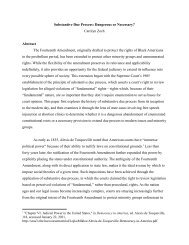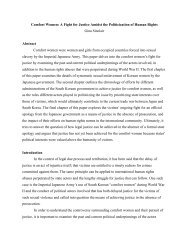Brown Undergraduate Law Review — Vol. 2 No. 2 (Spring 2021)
We are proud to present the Spring 2021 issue of the Brown Undergraduate Law Review. We hope that the works contained herein offer insight and inspiration to all who read them.
We are proud to present the Spring 2021 issue of the Brown Undergraduate Law Review. We hope that the works contained herein offer insight and inspiration to all who read them.
Create successful ePaper yourself
Turn your PDF publications into a flip-book with our unique Google optimized e-Paper software.
Standardizing Autonomy: Medical Communication, Liability, and the Doctrine of Informed Consent<br />
physician William Richards diagnosed her head injuries as<br />
a concussion, noting ?the possibility of intracranial<br />
bleeding.? 28 When Dr. Richards recommended to Martin?s<br />
family that she remain at Fort Atkinson Memorial Hospital<br />
(FAMH) for observation, he failed to mention that the<br />
hospital had no neurosurgeons on staff and thus would be<br />
incapable of treating a ?neurological complication such as<br />
intracranial bleeding? should such a risk materialize. 29<br />
Martin did in fact suffer an intracranial bleed during her<br />
stay at FAMH, and a helicopter rushed her to the<br />
calling that standard ?the very point of [Wis. Stat.<br />
§448.30]?: The court stated, ?Here the doctor was<br />
concerned about the possibility of an intracranial bleed.<br />
When a reasonable person would want to know about an<br />
alternative treatment or method of diagnosis such as a CT<br />
scan or hospitalization in a facility with a neurosurgeon,<br />
the decision is not the doctor?s alone to make.? 33 As such,<br />
the court reasoned that Wisconsin physicians?disclosure of<br />
?all alternate, viable medical modes of treatment? under<br />
Wis. Stat. §448.30 must include available treatment<br />
University of Wisconsin hospital in Madison where she options (and their material risks) for potential<br />
underwent two emergency surgeries several hours later;<br />
her injuries left her a ?partial spastic quadriplegic.? 30<br />
complications related to the patient?s diagnosis. Indeed,<br />
rather than being selectively filtered through a physician?s<br />
professional judgment, Martin v. Richards established that<br />
Martin and her family sued Dr. Richards for negligence,<br />
a physician?s disclosure must contain all that a ?reasonable<br />
and the applicability of their informed consent claim was<br />
person would [or could] want to know,? including<br />
debated extensively as the case moved through<br />
treatments for statistically rare but serious complications<br />
Wisconsin?s courts. After the Jefferson County Circuit<br />
like intracranial bleeding. Yet, ?reasonable? people will<br />
Court granted Dr. Richards? motion to dismiss the<br />
inevitably desire different degrees of risk disclosure, and<br />
informed consent claim, the Wisconsin Court of Appeals<br />
physicians cannot possibly intuit the scope of each<br />
reversed the circuit court?s dismissal and remanded the<br />
case. 31 patient?s expectation.<br />
The Wisconsin Supreme Court affirmed the appeals<br />
court?s decision on the basis of informed consent, finding<br />
Dr. Richards liable under the standard established by Wis.<br />
Stat. §448.30. Having considered the risk of an intracranial<br />
bleed, Dr. Richards claimed he did not believe Martin was<br />
bleeding at the time he diagnosed her concussion, and thus<br />
did not think she required care at a facility with a<br />
neurosurgeon. In his argument before Wisconsin?s<br />
Supreme Court, Dr. Richards posed the question, ?Why<br />
should we inform the patient that we don?t think we should<br />
do something?? 32 The Court responded by invoking the<br />
reasonable patient standard established by Canterbury,<br />
Wis. Stat. §448.30 and the precedent set by Martin<br />
informed the Wisconsin Supreme Court?s decision in<br />
Jandre v. Physicians Insurance Company of Wisconsin<br />
(2012), which expanded physicians?disclosure duty even<br />
further to include discarded diagnoses. Thomas Jandre was<br />
evaluated by emergency room physician Therese Bullis<br />
with symptoms of ?drooling, slurred speech and one-sided<br />
facial droop, dizziness, and leg weakness?; after testing<br />
Jandre for multiple types of stroke events (hemorrhagic<br />
and ischemic strokes) and brain tumors, Dr. Bullis<br />
diagnosed him with Bell?s palsy, a ?diagnosis of<br />
28. Ibid., 74.<br />
29. Martin by Scoptur v. Richards, 531 N.W.2d 74.<br />
30. Ibid.<br />
31. Martin by Scoptur v. Richards, 531 N.W.2d 75.<br />
32. Ibid., 531 N.W.2d 80.<br />
33. Ibid., 531 N.W.2d 80?81.<br />
<strong>Brown</strong> <strong>Undergraduate</strong> <strong>Law</strong> <strong>Review</strong><br />
36










